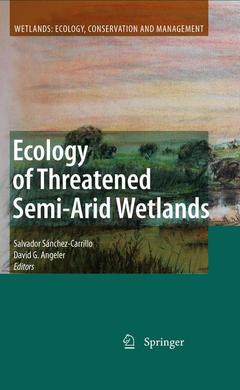Description
Ecology of Threatened Semi-Arid Wetlands, 2010
Long-Term Research in Las Tablas de Daimiel
Wetlands: Ecology, Conservation and Management Series, Vol. 2
Language: English
Subjects for Ecology of Threatened Semi-Arid Wetlands:
Publication date: 10-2012
292 p. · 15.5x23.5 cm · Paperback
Publication date: 08-2010
292 p. · 15.5x23.5 cm · Hardback
Description
/li>Contents
/li>Comment
/li>
Part I Introductory Chapter
1 The Wetland, Its Catchment Settings and Socioeconomic Relevance: An Overview
S. Sánchez-Carrillo, D.G. Angeler, S. Cirujano, and M. Álvarez-Cobelas
1.1 Introduction
1.2 The Wetland: Las Tablas de Daimiel National Park
1.3 The Upper Guadiana Basin and the UNESCO’s La Mancha Húmeda Biosphere Reserve
1.4 Groundwater Overexploitation and the Wetland Complex
1.5 Socioeconomic Aspects in the Upper Guadiana Basin
1.6 A Chronological Summary of TDNP Impacts and Its Degradation
References
Part II Abiotic Environment and Historical Reconstructions
2 Paleoenvironmental Reconstruction of Las Tablas de Daimiel and Its Evolution During the Quaternary Period
B. Ruiz-Zapata, M.J. Gil-García, and I. de Bustamante
2.1 Introduction
2.2 Material and Methods
2.3 Overview of Vegetation Composition in La Mancha Region During Quaternary Period: Palaeo-Sequences Description
2.3.1 Landscape Evolution from 325,000 to 21,000 Years BP: LT, TD, TASG-1 and FUENT-1 Profiles
2.3.2 Landscape Evolution from 11,000 to 4,000 Years BP: MO and CC-17 Sequences
2.3.3 Landscape Evolution from 4,000 Years BP to the Present: CC-17 and Gigüela 4.2 Paleo-records
2.4 Summary of Climatic and Wetland Environmental Evolution During the Quaternary Period
2.4.1 Middle Pleistocene
2.4.2 Upper Pleistocene
2.4.3 Holocene
References
3 Climate and Hydrologic Trends: Climate Change Versus Hydrologic Overexploitation as Determinants of theFluctuating Wetland Hydrology
S. Sánchez-Carrillo and M. Álvarez-Cobelas
3.1 Introduction
3.2 Material and Methods
3.3 Long-Term Climate Trends
3.4 An Historical Analysis of Wetland Hydroperiod and Inundation Patterns: The Importance of Groundwater
3.5 Long-Term Changes in the Wetland Water Budget: Hydrologic Degradation
3.6 Causes of Wetland Hydrologic Degradation: Climate Change Versus Hydrologic Overexploitation
3.7 Evapotranspiration Controls of Wetland Hydrology: A Conceptual Model
3.8 A Wetland Hydrological Model for Hydroperiod Restoration
3.9 Future Scenarios of TDNP Hydrology
References
4 The Effects of Anthropogenic Stressors on Wetland Loss and Habitat Quality Deterioration in the Upper Guadiana River Basin: A Long-Term Assessment (1970–2000)
R. Sánchez-Andrés, M.O. Viedma, and S. Sánchez-Carrillo
4.1 Introduction
4.2 Material and Methods
4.3 Wetland Cover and Extent of Hydrodynamic Types in the Early 1970s
4.4 Land Use–Land Cover Changes and Socioeconomic Indicators During 1978–2000
4.5 Wetland Losses from 1970 to 2000
4.6 Wetland Habitat Quality Evolution During the Period 1978–2000
4.7 Patterns on Wetland Loss and Habitat Quality Deterioration: the Infl uence of the Main Anthropogenic
Stressors at Local and Regional Scales
References
5 A Story of the Wetland Water Quality Deterioration: Salinization, Pollution, Eutrophication and Siltation
M. Álvarez-Cobelas, S. Sánchez-Carrillo, S.Cirujano, and D.G. Angeler
5.1 Introduction
5.2 Materials and Methods
5.3 Salinization and Major Ionic Composition
5.4 Water Pollution
5.5 Nutrient Dynamics and Eutrophication
5.6 Spatial Heterogeneity of Nutrient Controls
5.7 Wetland Sedimentation and Siltation
References
Part III Ecological Communities
6 Plankton Ecology and Diversity
C. Rojo and M.A. Rodrigo
6.1 Introduction
6.2 Materials and Methods
6.2.1 Field Sampling and Counting Techniques
6.2.2 Indexes and Statistical Methods
6.3 Diversity of Heterotrophic and Autotrophic Picopl
6.4 Bacteria and Autotrophic Picoplankton Dynamics
6.5 Species Composition and Diversity of Phytoplankton
6.6 Phytoplankton Abundance Dynamics
6.7 Species Composition and Diversity of Zooplankton
6.8 Zooplankton Abundance Dynamics
6.9 Bacterioplankton and APP Relationship with Abiotic and Biotic Factors
6.10 Environmental Factors Related to Phytoplankton
6.11 Environmental Factors Related to Zooplankton and the Food Web
References
7 Macrophyte Ecology and Its Long-term Dynamics
S. Cirujano, M. Álvarez-Cobelas, and R. Sánchez-Andrés
7.1 Introduction
7.2 Materials and Methods
7.2.1 Surveys and Reconstructions
7.2.2 Estimation of Growth and Decay
7.2.3 Biomass and Primary Production Estimations
7.2.4 Spatial Distribution of Helophytes
7.3 Aquatic Flora
7.4 Helophyte Cover and Growth
7.5 Plant Biomass, Production and Decomposition
7.6 Spatial Heterogeneity of Helophytes
References
8 Fish and Avian Communities: A Testimony of Wetland Degradation
M. Álvarez-Cobelas
8.1 Introduction
8.2 Fish Communities
8.2.1 Material and Methods
8.2.2 Results and Discussion
8.3 Avian Communities
8.3.1 Material and Methods
8.3.2 Results and Discussion
References
Part IV Applied Issues
9 Biomanipulation: A Useful Tool for Wetland Rehabilitation
D.G. Angeler
9.1 Introduction
9.2 Biomanipulation: Theory and Rationale
9.3 Biomanipulation in Wetlands: Applying a Lake Restoration Tool
9.4 Biomanipulation in Wetlands: Extending the Paradigm
9.5 Biomanipulation: A Model for Las Tablas de Daimiel
9.6 Conclusions and Perspectives
References
10 Analysis of Applied Environmental Management Strategies for Wetland Conservation During the Last 30 Years: A Local History
S. Cirujano, M. Álvarez-Cobelas, and C. Ruíz de la Hermosa
10.1 Introduction
10.2 Wetland Conservation in Spain Until 1970
10.3 Wetland Restoration, Conservation and Management Since 1970: Common Problems Across Spain
10.4 Las Tablas de Daimiel: A Case Study
References
Part V Cultural andSocietal Aspects
11 The Man and Las Tablas de Daimiel
M. Alvarez-Cobelas, S. Cirujano, and A. Meco
11.1 Early Settlement
11.2 From Roman Colonization to Lower Middle Age
11.3 Modern Age
11.4 The Twentieth Century
11.5 Ecosystem Health and the Future of Man in TDNP de Daimiel
References
Part VI Concluding Chapter
12 Synthesis: The Past, Present and Future of Las Tablas de Daimiel
David G. Angeler and Salvador Sánchez-Carrillo
12.1 Background and Current State of Las Tablas de Daimel
12.2 Missing Research Links: The Ecological Challenge
12.2.1 Research at the Local Scale
12.2.2 Research Beyond the Wetland Boundary
12.3 The Future: The Socioeconomic Challenge
12.4 Conclusion
References
Index




